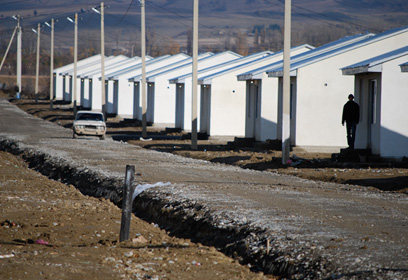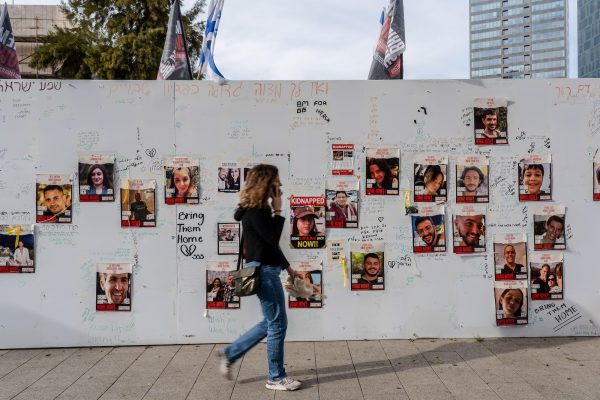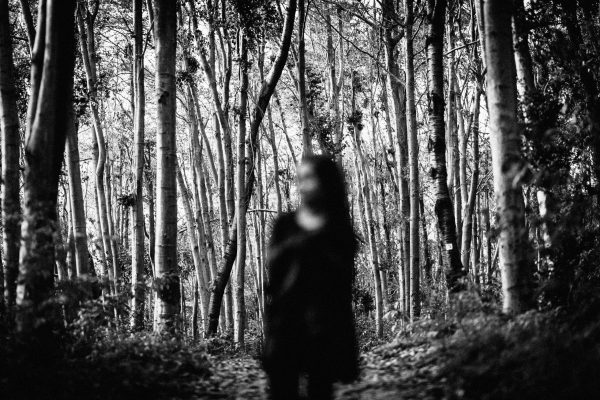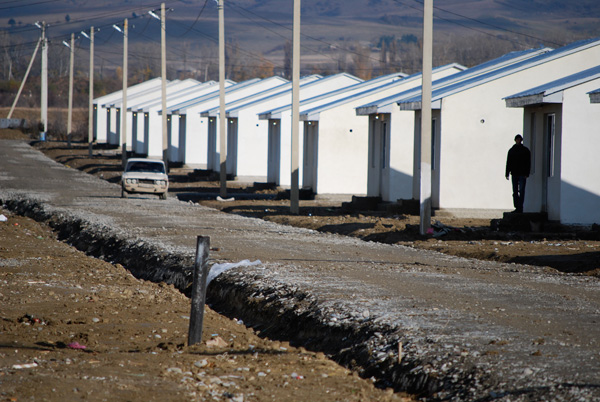
Skra, a camp in the Republic of Georgia, is considered one of the best refugee camps in the world. Although the cinderblock houses have electricity, there is no running water. Since the only source of heat is from the cottages' small wood stoves, displaced people cut down most of the camp's trees the first winter they lived there. Photo: Hannah Mintek.
Europe is currently encountering the arrival of tens of thousands of refugees from Syria, Afghanistan, and North Africa, who are braving the seas in rickety boats, streaming around fences, and occupying train stations in their quest to resettle. It is being called a “crisis,” but the term suggests a problem that will end. Thanks to more frequent and savage civil wars around the world, the global population of displaced people has more than tripled in the last ten years, from 20 million to more than 60 million, a population almost the size of the United Kingdom. European politicians may not want to admit it, but they are struggling with the central problem of twenty-first century global politics. Climate change, political instability, and other factors virtually guarantee that this century will see many more people made into refugees or economic migrants.
The problem is compounded by the total failure of the refugee camp as a humanitarian and political technology. Since the 1950s, Western Europe has tried to keep displaced people outside its borders by funding large-scale refugee camps in Third World countries. Despite the United Nations High Commission for Refugees' call for “durable solutions” for displaced people, the plan for most refugees is for them to wait in camps until they can return home, even when there is no foreseeable end to the wars or occupations that have displaced them. But while these camps offer politicians a convenient way to avoid making decisions about foreign wars and domestic immigration issues, the camps can only offer refugees a way of life that is permanently temporary. With no prospects for permanent relocation and the basic necessities for sustaining life in short supply, it is no surprise that displaced people are attempting the dangerous voyage to Europe.
• • •
“This isn’t living; it’s just existing,” Mzia Khizanishvili told me in the summer of 2014, as we sat outside her small cottage in a refugee camp in the Republic of Georgia. During the 2008 war between Georgia and Russia, Khizanishvili, a middle-aged school principal, became a victim of ethnic cleansing along with 28,000 other people in the breakaway province of South Ossetia. More than six years later, most of them were still stuck in the camps, which the government euphemistically called “new settlements.” With unemployment rates at more than 80 percent and little farmland available for the camp's residents, the internally displaced people in Georgia did what displaced people around the world do in refugee camps: they sat and waited to begin new lives.
The first time I walked into the camp, I was struck by its starkness. The streets, made of dusty white gravel, were barren and treeless; the rows of tiny cottages were one identical white cube after another. With no shops or churches or schools, no trees or bushes to variegate the landscape, and not even a bend in the road to break up the long march of houses, the settlement was so featureless it was disorienting. As one man asked on the day he moved in, “If I get drunk, how will I know where I live?” Even sober, I had problems. Whenever I did an interview in one of the cottages during the sixteen months I spent in the settlement between 2009 and 2011, I had to mark its location on a grid in order to find it.
Refugee camps are designed for the short term: to meet an emergency need and then disappear. The temporary nature of camps shows up in their architecture. In Jordan’s Zaatari refugee camp, more than 83,000 people are housed in row after stark row of simple tents that offer little shelter from snow, subzero temperatures, or flooding, even though there are no plans for the refugees to return to Syria or resettle anywhere else. In Nyarugusu camp in Tanzania, Congolese refugees are forced to build their own houses out of nothing more than thatch and unbaked bricks so that the United Nations High Commission for Refugees (UNHCR), the camp administrator, can raze the structures at any moment. “Impermanence is designed into the refugees’ most intimate spaces,” anthropologist Marnie Thomson says. “Their homes are constructed with destruction in mind.”
Nobody—the United Nations, host states, or international aid agencies—wants camps to be permanent. But the purgatory of camp life lasts decades or even generations, as the politics of refugees’ home countries remains unstable. The average length of stay in a refugee camp is now more than twelve years. The Palestinians are entering their sixty-seventh year of displacement. In Georgia, I met people displaced from a war in the province of Abkhazia twenty-three years ago, people who were still crowded in the crumbling ruins of old Soviet hotels officially designated as housing for displaced people, where raw sewage and busts of Stalin were contained by disintegrating concrete walls and rotting wooden floors. More than 200,000 people displaced from the Sudanese province of Darfur have been living in Zamzam Camp in shelters made of sticks and tarps for longer than twelve years. Neither likely to return home nor well integrated in the society where they are staying, these refugees are trapped in what UNHCR calls “a situation of protracted displacement.”
When people stay for so long, the bareness of camps, their lack of services, and their segregation from the surrounding society become chronic problems. Camps keep refugees alive, but they prevent them from living. Most camps lack schools, places of worship, and shops. Even when donors such as the United Nations or the Turkish government create camps with more permanent infrastructure, most lack the amenities a town of equivalent size would.
Camps keep refugees alive, but they prevent them from living.
Unemployment is rampant in refugee camps. Because many camps are deliberately placed far from urban areas in order to protect the local labor force, refugees find it difficult or impossible to find paying work, even when aid agencies provide microcredit loans or vocational training. Some Georgian camps are so remote that residents leave them and move into the capital to try and eke out a living selling pencils and cigarettes on the sidewalks or return to their damaged home villages under military occupation. Even life with the Russian 58th Army is preferable to a distant camp on a freezing windswept hillside where growing enough food is a struggle. In camps such as those in Tanzania and Thailand, where refugees are prohibited from any form of legal employment, refugees must resort to working underground, making them vulnerable to wage theft, arrest, or imprisonment.
Worst of all are so-called “closed camps,” where the host government prohibits refugees from leaving. In Nyarugusu Camp, in Tanzania, refugees may not go further than 4 kilometers from camp boundaries. Of course they do; they have to, to buy groceries, to work, or to see family members who do not have refugee status and who have settled illegally in nearby towns. When stopped by police, they have to pay large bribes or be arrested. “Even if we had better conditions, we are still in jail,” a Congolese refugee told Thomson.
Although they are not criminals, refugees are effectively incarcerated for an indefinite term. Cast into a permanently temporary state, in city-sized camps offering little hope of economic self-sufficiency, displaced people live in situations of imposed and institutionalized hopelessness. It is no surprise Syrians or Africans with resources and skills try to make it into Europe. It is their best chance of reintegrating into a developed society and rebuilding normal lives.
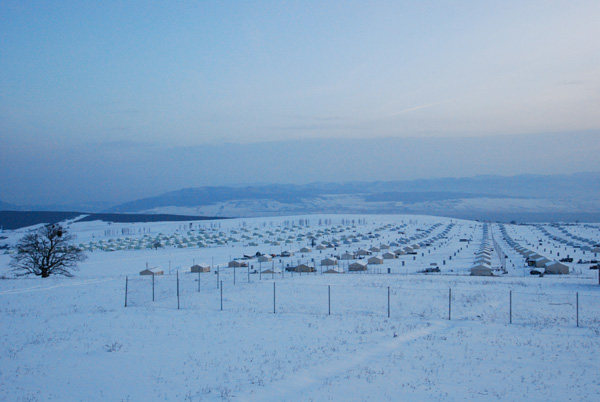
Prezeti, a camp for displaced people in the Republic of Georgia, is so remote that residents complain that packs of wolves follow children on their way to school. Because the camp is far away from jobs and urban services, many of its residents have returned to their home villages in South Ossetia, where they live under Russian military occupation. Photo: Hannah Mintek
• • •
Given that camps are unlikely to be truly temporary, why do the developed nations—mostly the United States and Western European countries—continue to fund them rather than push for more permanent solutions? In theory, camps make humanitarian aid more efficient. By collecting displaced people in a central location, aid agencies can reduce the costs of assessing refugees’ needs, shipping relief supplies, and distributing them. But displaced people are put in camps as much for political purposes as for humanitarian ones. Camps in the Third World keep displaced people offshore and out of sight.
The first modern camps for the displaced were within Europe’s borders. Between 1945 and 1951, Allied Forces and the United Nations Relief and Rehabilitation Administration managed French, German, and British camps that housed more than 850,000 displaced people mostly from Eastern Europe. But as those camps were emptied, largely by resettling displaced people in the United States and Canada, Western European countries came up with a plan to manage displacement in a way that would keep refugees, who were seen as politically dangerous and socially undesirable, out of Europe: they would outsource camps. Today, more than 80 percent of the world's displaced people are in developing countries. By funding UNHCR and other aid agencies, the world's wealthiest countries pay to keep them there.
During the Yugoslav Wars in the 1990s, another strategy emerged for keeping refugees at bay. “Safe zones” within war-torn countries prevent displaced people from crossing an international border, which makes them refugees under international law and allows them to demand asylum in neighboring countries. Keeping people in camp-based limbo also ensures their mobility, so if their home territory is retaken militarily, they can be quickly sent back to reoccupy it. This strategy has pushed the number of internally displaced people, or IDPs, to astronomical levels. In 1989 there were 17.2 million refugees and 16.5 million IDPs. In 2009, just before the Syrian Civil War broke out, the refugee population was roughly stable at 15.7 million people, but the IDP population had exploded to 27 million.
The enormous rise in the number of the displaced means there are fewer and fewer options for containment. Today there roughly 20 million refugees and more than 38.5 million IDPs, all of whom could potentially cross an international border and begin moving toward the developed world. At the same time, the United States and the EU countries are more reluctant to finance the rapidly growing archipelago of camps. By the end of 2014, only 25 percent of the UNHCR’s appeal for aid to Syrian refugees had been funded, and food, medicine, and energy were running out. The World Food Program, which gets its funding through the United Nations’ joint appeal process, dropped the budget for feeding Syrian refugees to a mere $13.50 per month. For many refugees, trying to get into Europe is not just about having a better life, it is about staying alive.
• • •
Clearly, the refugee crisis is here to stay. Although the United States has pledged to grant asylum to 100,000 refugees by the end of 2016, Germany nearly 800,000, and the European Union 160,000, there are 58 million more displaced people waiting for a permanent home. These numbers will continue to grow. Every man or woman who is beaten by Greek border police on the beaches of Lesbos or who crawls under the barbed wire fence separating Hungary from Serbia will challenge Western ideas about human rights and demonstrate the fragility of the European Union’s institutions for managing the collective action of its twenty-eight member states.
If immobilizing them in permanently temporary spaces and segregating them from surrounding societies is failing to keep migrants out of the developed world, how should the European Union and the United States respond to the oncoming wave of migrants? The only solution is to make permanence a human right and to help refugees create for themselves solutions that fully integrate them in their new societies early in their displacement.
This means no longer thinking about the refugee crisis as a problem of border control. Hungary’s fence is emblematic of this outdated view: it is premised on the notion that if refugees can be physically prevented from entering, the refugee problem will remain outside the boundaries of Europe. But as the U.S. attempt to control the Mexican border shows, would-be immigrants will enter legally if they can and illegally if they cannot.
The solution is not to fence them out or trap them in their home countries but to help them resettle in ways that benefit local economies and urban environments. Europe has an aging population, which is slowing economic growth and putting an enormous burden on social safety nets. An influx of young working people—computer repairmen, plumbers, architects and home health-care aides—could be an economic stimulus for Germany and Austria. Offering them flexible forms of aid, such as cash grants and housing vouchers, instead of isolating them in detention centers or other substitutes for the camp, will allow them to leverage the language skills, professional training, family ties, and financial resources they bring with them.
But those who choose to stay in camps—whether because they hope to eventually return home; remain close to relatives; or settle in a place with a language, religion, or culture more like their own—will need ongoing support from the West in order to integrate where they are instead of being forced to migrate. Rather than continually underfund temporary camps, the United States and the European Union must commit to funding durable housing and functional communities in the countries where refugees seek asylum. In countries such as Turkey, Pakistan, and Lebanon, which house 30 percent of the world’s refugees, an influx of aid to create real cities—places with sewage and electric systems, schools and libraries, public spaces and civic institutions—would stimulate local economies, create new jobs, and make it easier for host governments to see refugees as a boon instead of a burden.
The one thing that Europe and the United States cannot do is wait for war to end and for refugees to return home. Most of the longstanding conflicts producing refugees are not amenable to quick political resolution, and the enormous destruction of war means there are often no homes to return to. As Mamuka Khaduri, a veterinarian now marooned in an IDP camp in Georgia told me, there is no point in waiting for the time when refugees can go back where they came from. "We have to live as if we're going to live here forever.”
